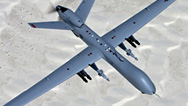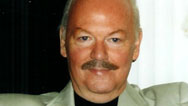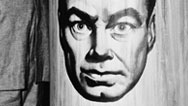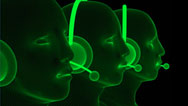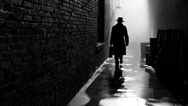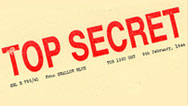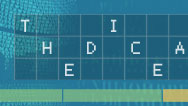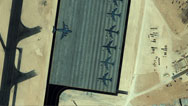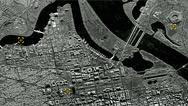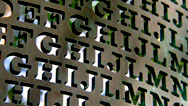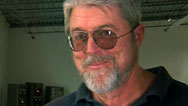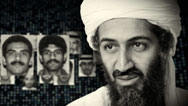
The Spy Factory
Examine the high-tech eavesdropping carried out by the National Security Agency. Airing February 03, 2009 at 9 pm on PBS Aired February 03, 2009 on PBS

Program Description
Transcript
The Spy Factory
PBS Airdate: February 3, 2009
NARRATOR: Halfway between Baltimore and Washington, D.C., is a hidden city, the headquarters of the National Security Agency, NSA. Here, tens of thousands of mathematicians, computer scientists, analysts, linguists and voice interceptors work in absolute secrecy.
JAMES BAMFORD (Author, The Shadow Factory): For those in the know, the joke was that NSA stood for "no such agency." For those on the inside, the joke was that NSA stood for "never say anything."
NARRATOR: NSA's job? To secretly listen in on telephone conversations, email communications, anything and everything that might warn of plots to do harm.
ERIC HASELTINE (National Security Agency, Director of Research, 2002–2005): The scope of what happens at NSA is mind-boggling. I don't think the average person can even begin to conceive of the staggering depth and breadth of what they have to do.
NARRATOR: But was NSA doing its job before the 9/11 attacks? It's a question that has never been thoroughly investigated.
MICHAEL SCHEUER (Former Central Intelligence Agency Analyst): None of this information that we're speaking about this evening is in the 9/11 Commission Report. They simply ignored all of it.
NARRATOR: But author James Bamford has investigated and come up with a chilling tale of terrorists, living in San Diego, communicating with bin Laden's operations center in Yemen, moving freely about, and all the while, NSA is listening in.
JAMES BAMFORD: But the NSA never alerted any other agency that the terrorists were in the United States and moving across the country towards Washington.
NARRATOR: Since the 9/11 attacks, NSA's role has grown even bigger, along with its license to listen in on Americans here and abroad.
ADRIENNE KINNE (Former National Security Agency Voice Interceptor): It was incredibly uncomfortable to be listening to private, personal conversations of Americans. It's almost like going through and finding somebody's diary.
NARRATOR: But is this flood of information making America any safer? Looking into The Spy Factory, right now on NOVA.
Major funding for NOVA is provided by the following:
One of the factors impacting energy prices is growing global demand. And one way to put downward pressure on prices is to make more supply available. ExxonMobil has invented a breakthrough technology that we've just begun using, here in the U.S., to access cleaner-burning natural gas that's locked in very tight, hard rocks. We could produce enough gas from one U.S. source alone to heat 50 million homes for almost a decade.
And David H. Koch. And...
Discover new knowledge: HHMI.
And by the Corporation for Public Broadcasting, and by contributions to your PBS station from viewers like you. Thank you.
NARRATOR: On the southbound lane of the Baltimore-Washington Parkway, traffic is stalled as commuters crowd down a special restricted exit that disappears into the thick woods. Beyond, hidden from view and protected by electrified fences and heavily armed guards, is the largest, most secret and most technologically advanced intelligence agency in the world: the National Security Agency, NSA.
Its mission: making and breaking codes; tapping into foreign signals, sifting through the international phone calls, emails, text and instant messages that blanket the modern world.
Every day, more than 20,000 people flood into this secret city. Unlike undercover CIA operatives, spying in hostile territory, NSA's spies use technology in what is believed to be the largest collection of mathematicians, linguists and computer scientists on the planet. Author James Bamford has written about NSA for the past 25 years.
JAMES BAMFORD: For the few in the know, the joke was always that NSA stood for "no such agency." For those on the inside, the joke was that NSA stood for "never say anything."
During the cold war, NSA circled nearly the entire Soviet Union with listening posts, to intercept military and diplomatic communications. NSA even listened in on Soviet leaders calling to the Kremlin from their limousines. At its headquarters in Fort Meade, Maryland, NSA used acres of supercomputers to break any coded communications.
NARRATOR: But when the Soviet Union collapsed, a new enemy emerged, one NSA was never designed to engage. That enemy was Al Qaeda. Eric Haseltine was NSA's Director of Research.
ERIC HASELTINE: The Russians were easy to find and hard to kill, and terrorists are hard to find and easy to kill.
NARRATOR: Unlike the Soviets, Al Qaeda was a small, scattered, moving target. Headquartered in remote, mountain training camps, its soldiers communicated by cell and satellite phones.
ERIC HASELTINE: And if you look at the job of NSA, to find the enemy, they had to go from looking at an enemy that they kind of knew who they were and where they were, to one that they didn't know who they were or where they were or how they communicated.
NARRATOR: For NSA, the challenge was to change tactics to match an increasingly dangerous adversary. In cities across Asia and the Middle East, Al Qaeda operatives were using public payphones and internet cafes to plan a series of strikes that would culminate in the 9/11 attacks.
TIM SAMPLE (Former Staff Director, United States Congress House Intelligence Committee): At that point, it was a race. It was a race between how much could we rebuild and have the type of capabilities that you need against an individual or a small group of individuals who operate around the world and pay little attention to borders. Can you do that? And can you rebuild the intelligence community in time?
NARRATOR: Those questions still resonate today. Was the National Security Agency, the organization responsible for intercepting foreign calls and messages, listening in on Al Qaeda prior to 9/11? What role did the NSA play? And are we any safer today?
Surprisingly, the 9/11 Commission never investigated the NSA's role as fully as it did those of the CIA or FBI, but by carefully piecing together a variety of unclassified public records, the story of NSA and its role in the "war on terror" emerges.
JAMES BAMFORD: In my research, I used thousands of documents available in the public record. They included intelligence agency memos, transcripts of terrorist trials, and a secret FBI chronology of the 9/11 terrorists' movements obtained under the Freedom of Information Act. One fact is clear from these sources: they were monitoring the Al Qaeda leader long before 9/11.
NARRATOR: In November, 1996, a known Al Qaeda contact buys an Inmarsat satellite phone from a store in a New York suburb. That phone is for Osama bin Laden. Once he starts dialing from Afghanistan, NSA's listening posts quickly tap into his conversations. Analysts at the CIA, like Michael Scheuer—head of Alec Station, the CIA's newly formed bin Laden tracking unit—are also eager to get the information.
MICHAEL SCHEUER: Osama bin Laden's Inmarsat telephone was really a godsend. It gave us an idea, not only of where he was in Afghanistan, but where Al Qaeda, as an organization, was established, because there were calls to various places in the world.
NARRATOR: For NSA, tapping into satellite calls is a basic tactic in what's known as "signals intelligence." Inmarsat phones transmit signals straight to a satellite orbiting over the Indian Ocean. By tracking all calls in and out of Afghanistan, the NSA quickly determines bin Laden's number: 873-682505331. Once they have this, they home in on both sides of his conversations, listening to bin Laden by means of a huge dish in space, and to the person he's speaking to with a dish-shaped antenna on the ground.
MICHAEL SCHEUER: In the intelligence business, signals intelligence is among the most important kind of intelligence options that you have—the electronic communications that are in the air, whether from telephone to telephone, from satellite to satellite, from Inmarsat radio to Inmarsat radio—and NSA collects those with a very broad array of electronic collection capability, but once you collect them, all you have is the signals. And ultimately, it all comes down to the human being.
NARRATOR: Human analysts plot out which numbers are being called from bin Laden's phone and how frequently. They quickly discover that most of the calls from bin Laden's phone in Afghanistan are going to a house in Yemen, 2,000 miles to the south.
JAMES BAMFORD: Yemen is central to understanding how Al Qaeda operates. It's where Osama bin Laden's father was born and raised. It has a culture of clans and secrets. It didn't surprise me that bin Laden chose its capital city, Sana'a, for his logistics and communications headquarters. What was surprising was that I found it tucked away in one of the city's poorest neighborhoods. The headquarters was hidden in a small undistinguished house the CIA said was the home of one of bin Laden's closest associates.
NARRATOR: Bin Laden's phone calls aren't encrypted, so there is no code for NSA's supercomputers to break. Instead, NSA voice interceptors and linguists painstakingly translate, transcribe and write summaries of the calls. The summaries are shared with the CIA, but its analysts at Alec Station want more. They believe that only by carefully studying each word will it be possible to understand bin Laden's intentions.
MICHAEL SCHEUER: Over time, if you read enough of these conversations, you first get clued in to the fact that maybe "bottle of milk" doesn't mean "bottle of milk." And if you follow it long enough, you develop a sense of what they're really talking about. But it's not possible to do unless you have the verbatim transcript.
We went to Fort Meade to ask then the NSA's deputy director for operations for the transcripts, and she said, "We are not going to share that with you." And that was the end.
NARRATOR: NSA declined NOVA's repeated requests for interviews, but its policy since its founding has been to never share raw data, even with other intelligence agencies. Scheuer is so determined to get it, he persuades the CIA to build its own ground station. But without a satellite, he can only get half of the conversations.
MICHAEL SCHEUER: We would collect it, translate it, send it to NSA and ask them for the other half of it, so we could better understand it, but we never got it.
NEWSCASTER (8/7/98): A terrorist attack on Americans half a world away.
NARRATOR: August 7, 1998: Al Qaeda strikes two U.S. embassies in east Africa.
NEWSCASTER (8/7/98): The principle suspect is Osama bin Laden.
NARRATOR: Both NSA and CIA are monitoring the Al Qaeda network, but neither gives any warning of the two precisely timed attacks.
MICHAEL SCHEUER: Truth of the matter is, though, we had various reports from human intelligence sources within East Africa that there was an Al Qaeda operation brewing somewhere on the east coast of Africa. We could never really pin it down.
NARRATOR: The embassy attacks are technically on American soil, so the FBI is called in and finds out about the house in Yemen.
MARK ROSSINI (Former Federal Bureau of Investigation Supervisory Agent): I first learned about the communications center in Yemen when I got to Nairobi, after the embassy bombing there. That house was a focal point for operatives in the field to call in, that number would then contact bin Laden to pass along information and receive instruction back.
NARRATOR: With only a handful of ways to pin down bin Laden's location—reconnaissance satellites, spies on the ground and signals intelligence—NSA's expertise is becoming increasingly important.
ERIC HASELTINE: If you've only got very few people who are hiding out in a cave somewhere, you're looking for a very small target and very few targets, as opposed to a big army division or a big missile complex. So, imagery intelligence was of relatively less value. Human intelligence, in an environment where a terrorist network is all relatives, blood relatives...it becomes tougher to get information in that kind of network.
I think one interpretation was that NSA understood that they were becoming more important, in the grand scheme of things, in the war on terror.
NEWSCASTER (10/12/00): An American ship is attacked in Yemen.
NARRATOR: October 12, 2000: Al Qaeda strikes again. This time, it's an attack on the U.S.S. Cole, moored off the coast of Yemen.
NEWSCASTER: Yemen's Port Authority had been penetrated...immediately suspect Osama bin Laden.
NARRATOR: Once again, the U.S. intelligence community fails to give a timely warning of the attack. Frank Blanco, NSA's Executive Director at the time, says NSA was still stuck confronting terrorist tactics with Cold War technology.
FRANK BLANCO (National Security Agency Executive Director, 1999–2001): You've got targets that are very mobile. They use a variety of communications, which are cell phones, laptops. NSA had to begin to think about, "What is the real technology that is necessary and how much is it going to cost and where do we get the money?"
NARRATOR: Money is a pressing issue. After the Cold War, Congress had reduced NSA's budget by a third, while criticizing it for violating privacy laws.
CONGRESSPERSON 1: ...concerned about the privacy rights of American citizens.
CONGRESSPERSON 2: There is no legitimate excuse for that.
CONGRESSPERSON 3: It is intolerable to think of the United States Government, of big brother, or anybody else...
NARRATOR: By law, NSA was prohibited from spying on American soil without approval from a special court, created by FISA, the Foreign Intelligence Surveillance Act.
JAMES BAMFORD: When I interviewed General Michael Hayden, the head of NSA, I was surprised when he told me that they were monitoring less than half a dozen people in the United States. He was very busy fighting Hollywood's image of NSA like you saw in movie, Enemy of the State.
GENE HACKMAN (Film Clip, Enemy of the State): The National Security Agency conducts worldwide surveillance. Fax, phones, satellite communications — they're the only ones including the military who could possibly have anything like this.
ERIC HASELTINE: To us, in the intelligence community, movies like Enemy of the State are quite amusing, because it made us look omniscient, we could collect anything we want and it's just not that way. It's not that way, at all. You may collect a lot of stuff, but you don't know what you've got. Really, the biggest technology challenge was how do you deal with volumes of information like that and find dots, connect dots and understand dots. That's the problem.
NARRATOR: In late December, 1999, NSA finds one very important dot: it intercepts an alarming call to the house in Yemen, instructing two Al Qaeda foot soldiers to fly to Kuala Lumpur, Malaysia, for what sounds like a terrorist summit. The foot soldiers are Khalid al-Mihdhar and Nawaf al-Hazmi. This is the phone call that sets in motion the 9/11 attacks.
JAMES BAMFORD: After picking up this critical call, NSA passed on their first names to the FBI and the CIA but not their last names. Nawaf's last name had been in the NSA's database for over a year, because of his association with bin Laden's operations center in Yemen, but apparently the NSA never looked it up.
NARRATOR: The CIA does find al-Mihdhar's name in its database. They ask security agents to make a copy of his passport as he passes through a checkpoint in Dubai. When analysts at CIA headquarters see it, they are astonished to find a valid U.S. visa inside. Alec Station, the CIA's bin Laden unit, now has two FBI agents detailed to it, Doug Miller and Mark Rossini.
MARK ROSSINI: Once they arrived in Kuala Lumpur, of course, the CIA requested the intelligence service over there in Malaysia to conduct surveillance of these subjects and find out as much as they can. They took photographs, followed them. And you read from that one of the individuals had a visa to come to the U.S.
NARRATOR: Fearing an Al Qaeda terrorist may be headed to the U.S., the agents are determined to tell the FBI, but a CIA official will not allow it.
MARK ROSSINI: I guess I was the more senior agent. So I went up to the individual that had the ticket on the Yemeni cell, the Yemeni operatives. And I said to her, I said, "What's going on? You know, we've got to tell the Bureau about this. These guys clearly are bad. One of them, at least, has a multiple-entry visa to the U.S. We've got to tell the FBI."
And then she said to me, "No, it's not the FBI's case, not the FBI's jurisdiction."
So I go tell Doug. And I'm like, "Doug, what can we do?" If we had picked up the phone and called the Bureau, I would have been violating the law. I would have broken the law. I would have been removed from the building that day. I would have had my clearances suspended, and I would be gone.
JAMES BAMFORD: This is one of the most astonishing parts of the story. The CIA had FBI operatives working within their bin Laden unit, but when the FBI operatives found out that one, and possibly two, of the terrorists had visas to the United States, were heading for the United States, the CIA wouldn't let them tell their headquarters that they were coming. Only the FBI could have put out alerts to stop Khalid al-Mihdhar and Nawaf al-Hazmi if they tried to enter the United States.
NARRATOR: January 15, 2000, Los Angeles International Airport: United Airlines Flight 2 arrives from Bangkok, where the CIA lost al-Mihdhar and al-Hazmi's trail. They pass through U.S. Immigration undetected. Within two weeks they move into the anonymity of a San Diego suburb.
MARK ROSSINI: The FBI put together this chronology as part of its investigation into the 9/11 attack. The timeline, the declassified copy, is the movements and the activities of the hijackers while they are in the U.S., hiding in plain sight.
NARRATOR: They get drivers licenses in their own names. They use a local bank to pick up international wire transfers from a known Al Qaeda finance chief. Their telephone number is even listed in the San Diego white pages: Alhazmi Nawaf M 858-279-5919.
JAMES BAMFORD: The CIA was forbidden from operating within the United States, and the FBI didn't know they were here, so the only way to track the terrorists was if NSA continued to monitor the conversations as they called back to the house in Yemen.
NARRATOR: But nine days after al-Hazmi and al-Mihdhar arrive in California, the NSA has a catastrophic failure.
FRANK BLANCO: I remember getting a phone call on January 24, 2000, that began with, "We have a problem." NSA systems had actually stopped working.
NARRATOR: The most technologically advanced intelligence agency in the world, capable of monitoring millions of simultaneous conversations, is deaf.
FRANK BLANCO: NSA was brain-dead. It took probably three to four, maybe even five days to bring everything back up the way it was.
NARRATOR: It is unclear whether, during those five days, NSA misses any calls from the hijackers in San Diego. But what is certain, as the FBI chronology spells out, is that the hijackers waste no time settling into their new neighborhood.
MARK ROSSINI: Here, as it says in the chronology: February 5, 2000: al-Mihdhar signed a lease to rent an apartment at 6401 Mount Ada Road, in San Diego.
February 25: Al-Mihdhar purchased a Toyota Corolla, in San Diego, California.
February 28: records at Progressive Insurance Company verify Al-Mihdhar's insurance policy, number 604725921-0, Huggy Bear Insurance Corporation.
March 20: the San Diego telephone number associated with Nawaf al-Hazmi made a call, which lasted 16 minutes, to Yemen.
NARRATOR: That is one of many calls made from San Diego to bin Laden's operations center, the house in Yemen that NSA has been monitoring for over three years. But NSA would not pass on that information to any other intelligence agency. Eleanor Hill investigated NSA's role in 9/11 for Congress.
ELEANOR HILL (Staff Director, United States Congress 9/11 Committee): We were very surprised to learn that, you know, they had this information. And if there are contacts from known terrorists in the United States with terrorist facilities abroad, that's exactly the kind of information our intelligence community needs to have. They didn't have it.
MARK ROSSINI: You put the NSA intel and the FBI intel together, you have both sides of the conversation. So they come in, we follow them, find out where they're going; listen to their homes, listen to their conversations at their home, or cell phone, whatever; emails. The possibilities are endless once you're able to peer into someone's life.
JAMES BAMFORD: Incredibly, the NSA never informed the FBI that these calls were coming from the United States, and we may never know why. No one from NSA will discuss it, and the 9/11 Commission never investigated it. They either didn't realize the two terrorists were calling from the United States—which is hard to believe because even I have caller I.D., which shows where calls are coming from—or what's more likely is that they ignored it because then they would have had to hand the contacts over to the FBI.
NARRATOR: April 12, 2000: almost three months after the hijackers arrive in the U.S., NSA director Michael Hayden hints at another possible explanation for NSA's silence. Already warned by Congress to respect Americans' privacy rights, Hayden responds to the House Intelligence Committee with extreme caution.
GENERAL MICHAEL HAYDEN (National Security Agency Director, 1999–2005): Let me put a fine point on this. If, as we are speaking here this afternoon, Osama bin Laden is walking across the Peace Bridge from Niagara Falls, Ontario, to Niagara Falls, New York, as he gets to the New York side, he is an American person. And my agency must respect his rights against unreasonable search and seizure, as provided by the Fourth Amendment to the Constitution.
JAMES BAMFORD: But General Hayden knew that the law permitted the agency to eavesdrop on the terrorists without interruption if they entered the United States.
MARK ROSSINI: You could link back who they were, their connection to bin Laden, the connection to the Yemeni house, et cetera. You could have gone to any court, any judge in the FISA court and say, "We want a FISA on that residence in San Diego."
It would have been easy. And we would have surveilled them, and we would have learned more information. People who are going to watch this, they're going to say, "Oh, it's hindsight 20–20." But, no, I'm not talking hindsight 20–20. I'm talking basic, logical investigation.
NARRATOR: Again, the FBI chronology, compiled after the 9/11 attacks, describes precisely how al-Mihdhar and al-Hazmi begin training for their 9/11 operation.
MARK ROSSINI: April 4, 2000: Nawaf al-Hazmi received one hour of introductory flight instruction from the National Air College, located at 3760 Glenn Curtis Road, San Diego.
May 4: Khalid al-Mihdhar debit card purchase: two Jeppesen training kits.
June 10, 2000: Al-Mihdhar departed U.S. via Lufthansa Flight 457 from Los Angeles, California to Frankfurt, Germany.
NARRATOR: Khalid al-Mihdhar is heading home to see a newborn son. For the next 13 months he will live with his wife and baby in the house in Yemen, the house NSA is monitoring. He will even apply for a new U.S. visa, and, incredibly, he will get it.
December 8, 2000: Hani Hanjour, another 9/11 hijacker, touches down in San Diego. Three days later he joins Nawaf al-Hazmi on a road trip to New Jersey, where the rest of the hijackers are assembling. Once more, the FBI chronology, compiled after the attacks, documents their five-month trip.
MARK ROSSINI: March 1, 2001: Hanjour has eight hours of simulator training at Jet Tech.
April 1: Nawaf al-Hazmi received a speeding ticket and received a summons for failure to wear a seatbelt.
May 1: Al-Hazmi filed a police report with Fairfax County, Virginia, police department, alleging he was mugged by an unknown black male.
NARRATOR: June 21, 2001: a reporter from the Middle East Broadcasting Corporation interviews bin Laden's lieutenants in Afghanistan. They hint that a major attack may soon take place. U.S. forces in the Mideast are put on the highest alert.
After the interview is released, NSA's traffic analysis detects a huge spike of threatening communications.
ELEANOR HILL: There was a great anticipation that there was going to be an attack on U.S. interests by Al Qaeda. Most people believed it was going to be overseas. And so, tragically, their focus was on their job, which was looking overseas and not so much on what was happening in the U.S., which they viewed as the FBI's job.
MARK ROSSINI: As the chronology goes on: July 4, 2001: Al-Mihdhar entered the U.S. on Saudi Arabian Flight 53, via J.F.K., in New York City, using a B1 business visa and listing his intended address as the Marriot Hotel, New York City. That was the Marriot Hotel at the World Trade Center.
NARRATOR: To make final preparations for their attack, al-Hazmi, al-Mihdhar and Hanjour drive south on the New Jersey Turnpike. They avoid staying in large cities. They avoid hotel chains with computerized registration. Instead, the crew drives into the Maryland town of Laurel and checks in to the low-budget Valencia Motel. By now they have their final assignment, targeting the Pentagon.
JAMES BAMFORD: Throughout their whole journey, whether they were in San Diego or they were in New Jersey or they were in Laurel, Maryland, they were communicating back and forth to the bin Laden ops center in Yemen. NSA was listening in on the ops center, recording the conversations and then transcribing them. But the NSA never alerted any other agency that the terrorists were in the United States and moving across the country, towards Washington.
NARRATOR: On the face of it, Laurel, Maryland, looks like a typical Washington suburb.
JAMES BAMFORD: What's very different is that this town happens to be right next door to NSA's headquarters.
NARRATOR: While NSA has detected a spike in communications threatening an imminent attack, Bin Laden's hit men have taken refuge right in their backyard.
MARK ROSSINI: August 18: Hani Hanjour rented mailbox number 433.
The day before the hijacking: Nawaf al-Hazmi, Walmart, $36.65; Food Factory, Khalid al-Midhar.
9/6/2001: Nawaf al-Hazmi, Khalid al-Midhar, Hani Hanjour: Gold's Gym, Greenbelt, Maryland.
JAMES BAMFORD: The hijackers seemed to blend in very well. Even when they shopped for improvised weapons for the hijackings, they shopped in a Target Store just down the street from NSA. No one thought what they were doing was suspicious.
So here you have these two groups of people: one, the terrorists who were plotting the largest terrorist operation in U.S. history. And you have NSA, which had been listening to some of their phone calls for years. And now they are living side by side, neither of them knowing that the other is there.
What was really tragic is that if General Hayden had looked out his eighth floor window, west, towards Laurel, just two miles away, he could have almost seen the motel in which the hijackers were living. I mean, it's one of the biggest ironies in the history of American intelligence.
NARRATOR: On the day of the 9/11 attacks, most of NSA's employees are ordered to leave their headquarters. Afraid that NSA might be another target, some of the few who remain move from their upstairs offices to lower floors. Others tack up black curtains to block their windows. They seem to have no idea what their own agency and the CIA both knew but had said nothing about.
ELEANOR HILL: Had we been able to realize how significant that was, put it together and get it to the agencies who could have made use of it in time, would there have been a different end to the 9/11 story?
MARK ROSSINI: I can't come up with a rational reason why I didn't break the rules, pick up the phone, and tell that the hijackers, or really bad guys, are in the U.S. And I don't know if I'll ever be able to come to terms with that. I don't know. I really don't know.
MICHAEL HAYDEN: On the 13th of September, I gave an address to an empty room, but we beamed it throughout our entire enterprise, about free peoples always having to decide the balance of security and their liberties, and then I told the workforce, there are going to be a lot of pressures to push that banner down toward security, and our job at NSA was to keep America free by making Americans feel safe again.
NARRATOR: Those pressures aren't long in coming. When Hayden is asked by Vice President Cheney what more NSA can do, he answers, "Not much, without breaking FISA laws," the laws force that force NSA to obtain a warrant to listen in on Americans.
Three weeks after the attacks, President Bush bypasses those laws, by secretly issuing an executive order: NSA will no longer have to worry about obtaining warrants to eavesdrop inside America. If 9/11 was a wake-up call, the response is a license to listen to almost anything and everything.
TIM SAMPLE: And part of that wake-up call, certainly right after 9/11, included the fact that you needed to take some strict measures. You needed to take some action that would allow you to not let that happen again.
NARRATOR: But to make the new program work, Hayden must finally bring the National Security Agency into the modern age. The backbone of global communications had moved from easily intercepted satellite signals in space, to fiber optic cables buried under the ocean. To understand the challenge NSA faces, NOVA follows one email message as it circles the globe.
In Malaysia's capital city of Kuala Lumpur, James Bamford is researching Al Qaeda's communications network. In a busy cafe, he types out an email message to NOVA's producers, in Boston. Bamford's message is harmless but contains the kinds of keywords and phrases that NSA supercomputers are programmed to detect, phrases like "blow up the White House," "destroy the Capitol building," "biological warfare."
When he presses "send," Bamford's message is instantly mixed in with dozens of other messages on the same wireless network, then routed to a large telecommunications center in the city. There, voice calls are converted from analog to digital signals and streamed, as pulses of light, through a fiber optic cable that dives into the South China Sea, off Malaysia's Coast.
Along the way, Bamford's message is merged with thousands of phone calls, emails and faxes, in dozens of languages, from hundreds of Asian cities. The jumble of data crosses under the Pacific Ocean at the speed of light.
Just five hundredths of a second after the message was sent, it comes ashore, six feet under this lonely stretch of California beach, near Morro Bay. There, beneath screeching gulls and surfers in wet suits, Asian communications stream in. A few miles inland, the message passes through a small, nondescript building near San Luis Obispo.
JAMES BAMFORD: If you want to tap into international communications, it seems like the perfect place is San Luis Obispo. That's where 80 percent of all communications from Asia enters the United States.
NARRATOR: But under NSA's new orders, they don't tap in here. Instead the cables run straight from San Luis Obispo to a building in San Francisco.
The building, at 611 Folsom Street, is AT&T's regional switching center. All the international traffic snakes up to the seventh floor, and it is here that a crucial change takes place. The seventh floor is also where AT&T's domestic traffic is routed—a cacophony of millions of conversations: cries and laughter, hopes and dreams, emails, faxes, bank statements, hotel reservations, love poems and death notices, all sent by people from inside the United States. The only thing they have in common is a reasonable expectation of privacy.
NARRATOR: In 2003, an AT&T engineer notices that the cables on the seventh floor have been rerouted, and a mirror image of all the traffic, both domestic and international, is now being sent to a secret room one floor below.
MARK KLEIN (Former AT&T Technician): It was obvious that this was some kind of NSA installation. I figured out that what they were doing was a blind wholesale copying of the entire internet data flow. And this meant randomly scooping up huge amounts of purely domestic data, as well as international data.
BRIAN REID (Internet Systems Consortium): When I hear the word wiretap, I've always imagined some person in a trench coat and a black hat and sunglasses, skulking around after dark, secretly tapping into a wire and hoping that no one notices. But what they've done in that facility is by full light of day, they've cut the fiber optic cables and then reconnected them in a splitter. What they have built is a facility that is capable of monitoring absolutely all data communication through it.
NARRATOR: Brian Reid, a communications expert, has examined AT&T's internal documents that Klein provided. They show that the secret room contains electronic equipment specifically designed for signals intelligence, equipment programmed to sift through millions of messages, searching for keywords like the ones Bamford sent from Kuala Lumpur.
BRIAN REID: The most curious piece of equipment in that room is a completely flexible monitoring system that can be told on a moment's notice, "Please monitor all conversations that contain the word hummingbird. Please monitor all conversation that goes to Mobile, Alabama. Please monitor all conversations that contain both the word hummingbird and go to Mobile, Alabama."
NARRATOR: NSA has turned its giant ear to listen in on America.
BRIAN REID: Based on everything I know, I believe that there are between 15 and 30 of these secret rooms around the U.S.
NARRATOR: The post-9/11 rules authorized NSA to listen in to Americans both inside and outside the U.S., without any special court approval.
ADRIENNE KINNE: After 9/11, we were essentially put in charge of a new system which intercepted satellite phone communications in Iraq and Afghanistan and surrounding areas.
NARRATOR: Calls and data from the Middle East and North Africa are collected and relayed to a listening post, tucked in the hills, outside Augusta, Georgia. As a voice interceptor, Adrienne Kinne listened to some of those calls. Assigned by the Army to NSA, she was called back to active duty after 9/11.
ADRIENNE KINNE: For a voice interceptor, the computer system would essentially pop up, and it would be very similar, I would say, to iTunes, where you could just go through and click on various conversations, and it would have the phone number, the time up, time down. We were told that we were to listen to all conversations that were intercepted, to include those of Americans and other allied countries.
NARRATOR: Some of those conversations are personal, some even intimate.
ADRIENNE KINNE: And there was no directive to say that when you had conversations like this come through, that you should delete them. That's what we did when I was on active duty in '94 to '98. We would never collect on an American. I had a real problem with the fact that people were listening to it and I was listening to it. The time that that interceptor, that voice interceptor, is spending listening to conversations in the States, that's time that they can't spend looking or listening for actual conversations related to terrorist organizations.
NARRATOR: As NSA began tapping in to fiber optic cables as well as satellites, information began to flood in like never before.
According to a Congressional study in 2008, some intelligence data sources grow at a rate of four petabytes—that's four quadrillion bytes—per month, the equivalent of 12 filing cabinets of new information for every American citizen, every year. But what does it all mean?
ERIC HASELTINE: Computers, today, tell people what things are: "Here's some data that you asked for." They don't tell you what it means. So there is some work going on to try to marry the power of computers to the power of humans.
NARRATOR: Specialized software can help extract important information based on context and meaning. Dr. Robert L. Popp does advanced research on these kinds of programs, known as classifiers.
DR. ROBERT L. POPP: Say you wanted to build a classifier for Al Qaeda, the term, the concept, Al Qaeda. The way it would work is you, as an analyst, would go find all these documents—whether they're emails or things on the web or whatever—but all these documents that in your judgment are narratives associated with the concept of Al Qaeda.
NARRATOR: In the future, by refining the software and harnessing enough computing power, these classifiers could potentially reduce the mountain of information human analysts have to examine.
ERIC HASELTINE: So the next frontier may be, "Computer, do you see any unusual associations that I didn't think to ask you about that I ought to have asked you about when it relates to a threat against the homeland?"
NARRATOR: But most experts agree that may take decades. And it could only help mine information in documents, emails and faxes. When it comes to human conversations, technology is of little help. It still takes people wearing headphones and listening in.
DAVID MURFEE FAULK (Former National Security Agency Voice Interceptor): I decided, a couple weeks after 9/11, to enlist, and go do Arabic. And I hoped to go hunt Osama at that time.
NARRATOR: David Murfee Faulk was one of the thousands of new linguists trained to work in the trenches of NSA's signals intelligence operations.
DAVID MURFEE FAULK: NSA spends literally billions of dollars to obtain signals, to process them, move them from place to place without people knowing, to get them to an end user, a translator who can make some sense of them and write up a transcription.
What I found was a large number of translators simply not meeting minimal requirements in language skills, basically running some very expensive, very complicated equipment, without the kind of knowledge or context that they would need to do that properly.
NARRATOR: Before 9/11, the budget for U.S. intelligence was $26.7 billion. By 2008 that budget nearly doubled. NSA's portion is secret, but believed to be over a third, more than the departments of Treasury, Interior or Labor. Its ranks have swelled to over 35,000.
TIM SAMPLE: Given all the additional money spent now, on rebuilding the intelligence community and its capabilities, are we really safer as a nation? I think generally, for me, the answer is yes—the fact that we haven't had another attack, the fact that we have better coordination and better information-sharing. Are we to the point where we can relax and put our guard down? No. I think if we do, then we run the risk of changing the answer.
ELEANOR HILL: It's very, very hard to draw a hard and fast line between where foreign intelligence stops and domestic intelligence starts. That doesn't mean we want our foreign intelligence agencies on every street corner in America. But it does mean that you have to have very good communication and coordination between the foreign intelligence agencies, like the CIA and NSA, and our domestic agencies, like the FBI,
because if you don't, things are going to slip between the cracks. And that's exactly what happened with 9/11.
JAMES BAMFORD: The problem with reporting on a story like this is that you're really searching in the dark. There's no way to sit on the outside and really know what's going on on the inside.
And, without an official inquiry, some questions can't be answered: Why did the NSA fail to act or pass on information that could have warned of 9/11? Why didn't it share information with the CIA and FBI that could possibly have stopped the plot?
As for the question of whether we are any safer now than we were before, we should have been safe the way it was. NSA had all the information that it needed to stop the hijackers, and it already had laws that allowed it to track them. So now, with NSA's new rules, with all the money it's spent, with all the data it collects, is NSA doing a better job or is its job that much harder because it's just being flooded with data? How much information is enough, and won't too much information end up making the world more dangerous?
NARRATOR: On NOVA's Spy Factory Web site, dig deeper into this topic, with original content including interactives, interviews and more. Find it on PBS.org.
This NOVA program is available on DVD. The companion book, The Shadow Factory, is also available. To order, visit shoppbs.org or call us at 1-800-PLAYPBS.
NOVA is a production of WGBH Boston.
Broadcast Credits
The Spy Factory
- Written and Produced by
- James Bamford
- Produced and Directed by
- C. Scott Willis
- Edited by
- Todd Sali
- Director of Photography
- Neil Barrett
- Art Director
- Ekin Akalin
- Narrated by
- Jay O. Sanders
- Music & Sound Design
- Jonathan Mitchell
- Associate Producer
- Michael Dolan
- Assistant Editor
- Magee McIlvaine
- Graphic Designers
- Hande Hersekli Baris
Collin Willis - Visual Effects Supervisor
- Todd Sali
- Additional Camera
- Ekin Akalin
Phil Geyelin Jr.
Magee McIlvaine - Colorists
- Todd Sali
Ted Snavely - Audio Mix
- Christopher Anderson
- Archival Material
- ABC Videosource
BBC Motion Gallery
National Archives and Records Administration
ITN Source
AP Images
Corbis
Reuters
Digital Globe
GeoEye
National Aeronautics and Space Administration
Library of Congress, Motion Picture, Broadcasting and Recorded Sound Division
SES
Space Systems/Loral
Sandia National Laboratories, U.S. Department of Energy
ICO Global Communications
Defense Imagery Management Operations Center
National Security Agency - Special Thanks
- BlueRidge Mac
Bono Film and Video
Darius Fisher
Logan Hardware
Photo Response
San Diego Public Library - NOVA Series Graphics
- yU + co.
- NOVA Theme Music
- Walter Werzowa
John Luker
Musikvergnuegen, Inc. - Additional NOVA Theme Music
- Ray Loring
Rob Morsberger - Post Production Online Editor
- Michael H. Amundson
- Closed Captioning
- The Caption Center
- Publicity
- Carole McFall
Eileen Campion
Victoria Louie
Karinna Sjo-Gaber
Karen Laverty - Marketing
- Steve Sears
- Researcher
- Kate Becker
- Senior Researcher
- Gaia Remerowski
- Production Coordinator
- Linda Callahan
- Paralegal
- Sarah Erlandson
- Talent Relations
- Scott Kardel, Esq.
Janice Flood - Legal Counsel
- Susan Rosen
- Production Assistant
- Ryan Murdock
- Post Production Assistant
- Darcy Forlenza
- Associate Producer, Post Production
- Patrick Carey
- Post Production Supervisor
- Regina O'Toole
- Post Production Editors
- Rebecca Nieto
Jason York - Post Production Manager
- Nathan Gunner
- Compliance Manager
- Linzy Emery
- Development Producer
- Pamela Rosenstein
- Supervising Producer
- Stephen Sweigart
- Business Manager
- Joseph P. Tracy
- Senior Producer and Project Director
- Lisa Mirowitz
- Coordinating Producer
- Laurie Cahalane
- Senior Science Editor
- Evan Hadingham
- Senior Series Producer
- Melanie Wallace
- Managing Director
- Alan Ritsko
- Senior Executive Producer
- Paula S. Apsell
A NOVA Production by C. Scott Films LLC for WGBH Boston
© 2009 WGBH Educational Foundation
All rights reserved
- Image credit: (sound wave, recreation) © 2009 WGBH Educational Foundation
Participants
- James Bamford
- Author, The Shadow Factory
- Frank Blanco
- NSA Executive Director, 1999-2001
- Eric Haseltine
- NSA Director of Research, 2002-2005 www.leighbureau.com/speaker.asp?id=431
- Michael Hayden
- Former Director, NSA Director (1999-2005), CIA (2006-2009)
- Eleanor Hill
- Staff Director, Congressional 9/11 Committee www.kslaw.com/bio/Eleanor_Hill
- Adrienne Kinne
- Former NSA Voice Interceptor
- Mark Klein
- Former AT&T Technician www.pbs.org/now/shows/307/mark-klein.html
- David Murfee Faulk
- Former NSA Voice Interceptor
- Brian Reid
- Internet Systems Consortium www.isc.org/
- Mark Rossini
- Former FBI Supervisory Agent
- Tim Sample
- Former Staff Director, House Intelligence Committee
- Michael Scheuer
- Former CIA Analyst
Preview
Full Program
Full program available for streaming through
Watch Online
Full program available
Soon

